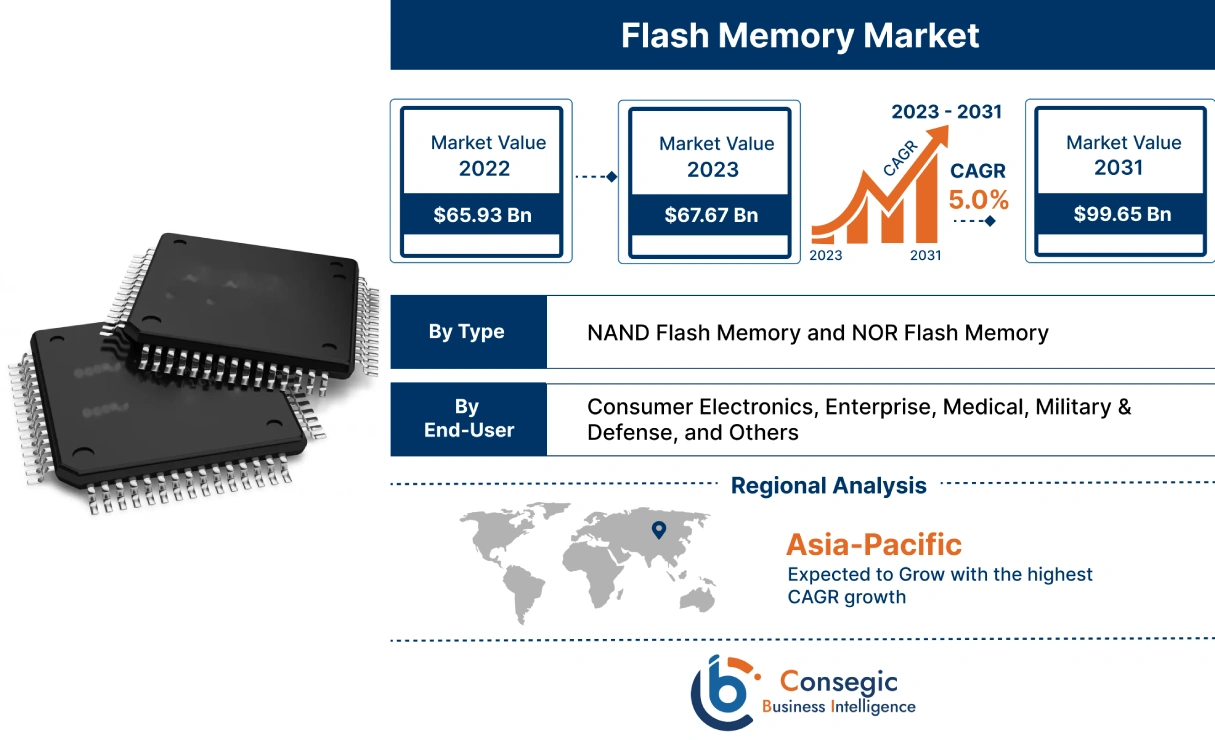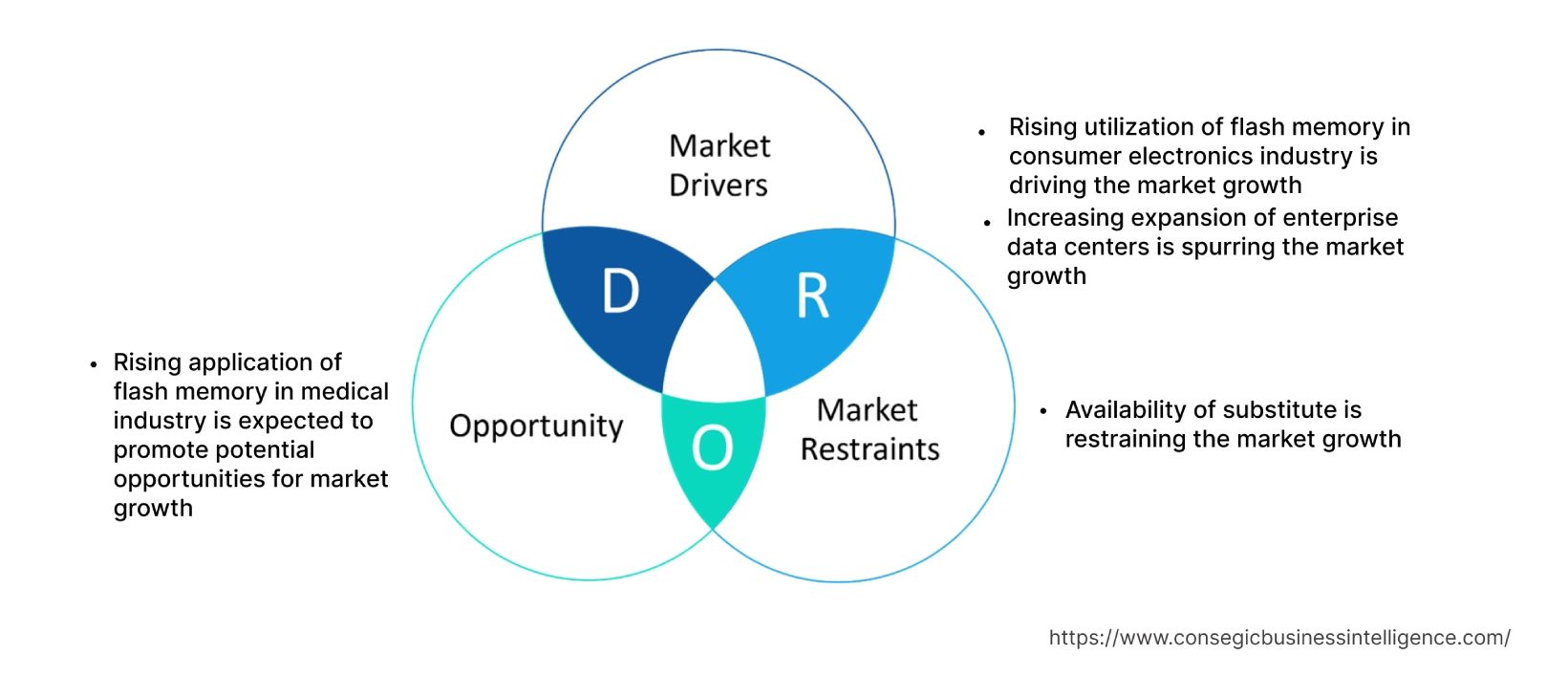Flash Memory Market Size :
Flash Memory Market size is estimated to reach over USD 99.65 Billion by 2031 from a value of USD 65.93 Billion in 2022 and is projected to grow by USD 67.67 Billion in 2023, growing at a CAGR of 5.0% from 2023 to 2031.
Flash Memory Market Scope & Overview:
Flash memory refers to an electronic non-volatile computer memory storage medium that can be electrically erased and reprogrammed. There are two primary types of flash memory including NAND flash and NOR flash memory. Moreover, flash memory offers several benefits including high speed transfer rates, durability, high reliability, faster read/write speed, portability, and others. The aforementioned benefits of flash memory are key determinants for increasing its utilization in consumer electronics, enterprise, medical, military & defense, and others, and other sectors.
How AI is Impacting the Flash Memory Market?
AI is impacting the flash memory market by driving an unprecedented demand for high-performance, high-capacity storage. The intensive data requirements of AI model training and inference, particularly for generative AI, necessitate incredibly fast and reliable data access. This fuels innovation and adoption of advanced flash technologies like 3D NAND with higher layer counts and faster interfaces such as PCIe Gen 5. Moreover, AI is being integrated directly into flash memory controllers to optimize data management, extend endurance, and enhance power efficiency. This in turn ensures flash solutions can meet the rigorous demands of AI workloads in cloud data centers, edge computing, and AI-powered devices.
Flash Memory Market Insights :
Flash Memory Market Dynamics - (DRO) :
Key Drivers :
Rising utilization of flash memory in consumer electronics industry is driving the market growth
Flash memory is primarily used in the consumer electronics industry, particularly in smartphones, computers, digital cameras, television, wearable devices, and other related consumer devices. Moreover, flash memory is used for storage and data transfer applications in consumer devices. The benefits of flash memory including high speed transfer rates, durability, and high reliability are key determinants for increasing the utilization of the chip in consumer electronic devices.
Factors including adoption of AI (Artificial Intelligence) and IoT (Internet of Things), growing penetration of smartphones, and rising need for efficient storage solutions are key prospects driving the adoption of flash memory.
According to the Brazilian Electrical and Electronics Industry Association (ABINEE), the value of electrical and electronics industry in Brazil reached USD 42.2 billion in 2022, depicting an increase of nearly 8% in comparison to USD 39.2 billion in 2021. Additionally, according to the Association of German Banks, the German electronics sector witnessed a considerable growth in 2021. The manufacturing and nominal sales of electronics sector witnessed an incline of 10% in 2021 as compared to 2020.
Hence, the growing consumer electronics sector is increasing the utilization of flash memory in smartphones, computers, wearables, and other consumer devices, in turn driving the market growth.
Increasing expansion of enterprise data centers is spurring the market growth
Flash memory is used in enterprise data center servers, storage, and networking solutions for storing large volumes of data and electronic information. The non-volatile characteristics and faster read/write speeds of flash memory are ideal for utilization in data centers for high speed storage and data transfer applications among others.
Factors including the rapid pace of digital transformation, increasing deployment of cloud services, expansion of data centers, and rising demand for higher capacity server storage solutions are among the major prospects driving the adoption of flash memory.
For instance, in November 2021, Tencent Cloud launched new data center in Brazil in order to fulfill the rising demand for digitalization in Latin America. The launch of the new data center provides highly reliable and stable cloud services to facilitate the growth of Brazilian and other Latin America-based businesses.
Additionally, NTT Ltd. launched hyper scale data centers in Chennai, India with an overall planned capacity of 34.8 MW critical IT load. Hence, the rise in development of data centers is driving the adoption of flash memory for application in data center servers, storage, and networking solutions for storing large volumes of data and electronic information, in turn proliferating the growth of the market.
Key Restraints :
Availability of substitute is restraining the market growth
The primary substitute for flash memory includes Resistive Random-Access Memory (RRAM) among others. Comparatively, the substitutes have similar properties, performance, and applications, with respect to flash memory, which is a prime factor restricting the market growth.
For instance, the utilization of resistive random-access memory (RRAM) enables storage devices to flip between two resistance levels to store binary data. RRAM offers faster switching speed, smaller devices, and 10x improvement in wear life as compared to flash memory.
Additionally, in November 2022, Weebit introduced RRAM (resistive random access memory) as a replacement to flash memory. The company's resistive random access memory offers various benefits in terms of power, endurance, cost, and reliability in comparison to flash memory. Therefore, the availability of substitute for flash memory with improved operational benefits is constraining the growth of the market.
Future Opportunities :
Rising application of flash memory in medical industry is expected to promote potential opportunities for market growth
The rising application of flash memory in the medical industry is expected to present potential opportunities for the growth of the flash memory market. Flash memory is often used in medical devices due to range of benefits inclduing modular form factors, high reliability, enhanced performance, and long life cycles.
Factors including the increasing trend in healthcare expenditure, rising surgical and diagnostic procedures, and growing investments in production of advanced medical devices are driving the growth of the medical industry.
According to the European Medical Technology Industry, the medical device sector in Germany accounted for 25.8% of the total share of the medical device industry Europe in 2021, followed by France with 14.3%, UK with 10.4%, Italy with 9.0%, and Netherlands with 6.4% among others.
Additionally, according to the International Trade Administration (ITA), the medical device sector in Canada was valued at USD 6.5 billion in 2022, with primary activities including research & development and manufacturing of medical diagnostic, and therapeutic devices. Therefore, the growth of medical industry is anticipated to increase the integration of flash memory in medical devices for storage of medical test results, images, and other sensitive information, in turn promoting opportunities for market growth during the forecast period.
Flash Memory Market Report Insights :
| Report Attributes | Report Details |
| Study Timeline | 2017-2031 |
| Market Size in 2031 | USD 99.65 Billion |
| CAGR (2023-2031) | 5.0% |
| By Type | NAND Flash Memory and NOR Flash Memory |
| By End-User | Consumer Electronics, Enterprise, Medical, Military & Defense, and Others |
| By Region | North America, Europe, Asia-Pacific, Latin America, and Middle East & Africa |
| Key Players | Samsung, STMicroelectronics, Micron Technology Inc., Toshiba Corporation, SK Hynix Inc., Intel Corporation, Infineon Technologies AG, Microchip Technology Inc., KIOXIA Holdings Corporation, Renesas Electronics Corporation |
Flash Memory Market Segmental Analysis :
By Type :
Based on the type, the market is bifurcated into NAND flash memory and NOR flash memory. The NAND flash memory segment accounted for the largest revenue share in the year 2022. NAND flash memory is a type of non-volatile storage that retains the data even in absence of power. Moreover, NAND flash memory offers several benefits including faster read/write speed, higher capacity storage, lower manufacturing cost, and reprogram ability among others. The above benefits of portable NAND flash memory are further increasing its utilization in consumer electronics, medical devices, and other related applications.
For instance, in August 2022, SK Hynix introduced its new 238-layer 4D NAND flash memory that features compact design, improved productivity, faster data transfer speed, and high power efficiency. Thus, the rising innovations associated with NAND flash memory is a prime factor proliferating the growth of the segment.
The NOR flash memory segment is anticipated to register the fastest CAGR growth during the forecast period. NOR flash memory is a type of non-volatile memory that is primarily used in electronic devices for storing data. NOR flash memory is usually available in the form of integrated circuits. Moreover, NOR flash memory offers multiple benefits including higher read capability, high data retention capability, random access interface, dense memory, and others. Additionally, NOR flash memory is primarily used in consumer devices, medical devices, and military & defense systems among others.
For instance, in February 2023, Infineon Technologies AG launched its new SEMPER Nano NOR flash memory designed for electronic devices. The NOR flash memory is optimized for utilization in wearable and industrial applications including health monitors, fitness trackers, GPS trackers, drones, and others. Thus, the increasing development of NOR flash memory for utilization in consumer electronics and industrial applications is a vital factor expected to drive the growth of the market during the forecast period.
By End-User :
Based on the end-user, the market is segregated into consumer electronics, enterprise, medical, military & defense, and others. The consumer electronics segment accounted for the largest revenue share of 38.63% in the year 2022. Factors including growing penetration of smartphones, computers, and other consumer electronic devices, and rising popularity of smart wearable devices are driving the growth of the consumer electronics segment.
According to GSM Association, the adoption of smartphones in Germany is projected to reach 84% by 2025, witnessing an incline from 80% in 2021. Additionally, according to Japan Electronics and Information Technology, the overall production by the Japanese electronics sector reached up to USD 95.2 billion in 2021, depicting an increase of 9.9% in contrast to 2020. Thus, the growing consumer electronics sector is increasing the utilization of flash memory in smartphones, computers, wearables, and other consumer devices, in turn driving the growth of the market.
Enterprise segment is expected to witness fastest the CAGR growth during the forecast period. The growth of the enterprise segment is attributed to several factors including rising investments in development of business enterprises, expansion of enterprise data centers, and growing demand for reliable server and storage solutions among others.
For instance, according to the Key 2021 Statistics for Singapore SMEs, the total number of enterprises in Singapore reached 291,600 in 2021, witnessing a growth of 6.8% as compared to 273,100 enterprises in 2019. Flash memory is primarily used in enterprise data center servers, storage, and networking solutions for higher and efficient data storage capacity. Thus, the rising expansion of business enterprises is among the key factors contributing to the growth of the market during the forecast period.
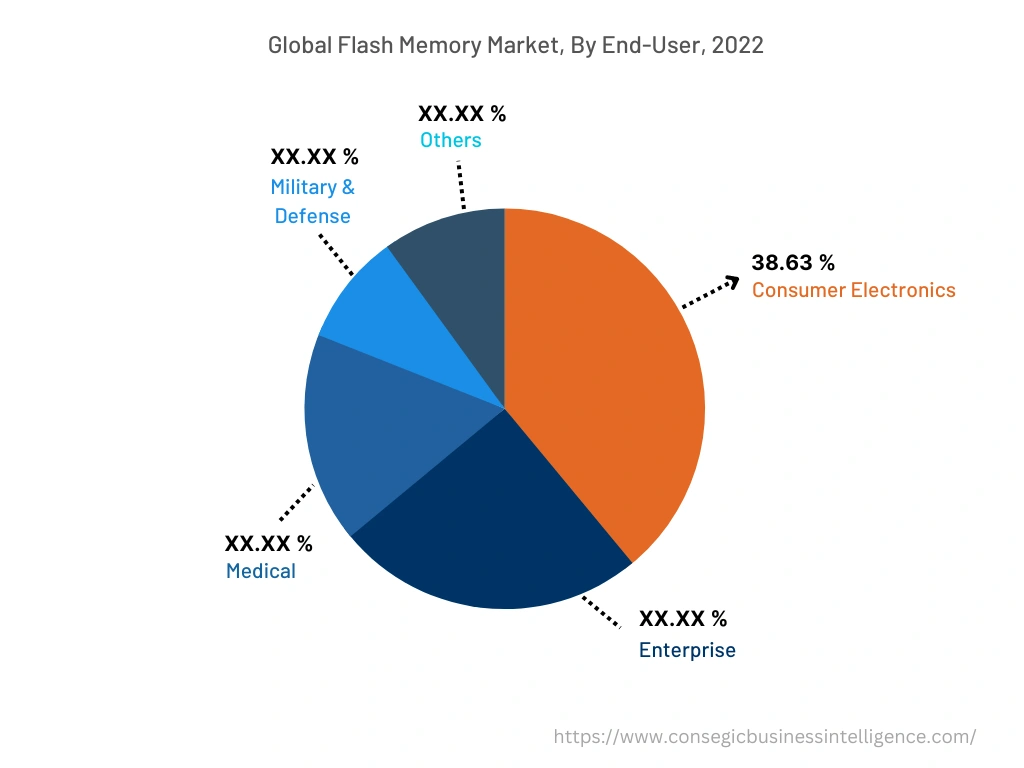
By Region :
The regional segment includes North America, Europe, Asia Pacific, Middle East and Africa, and Latin America.
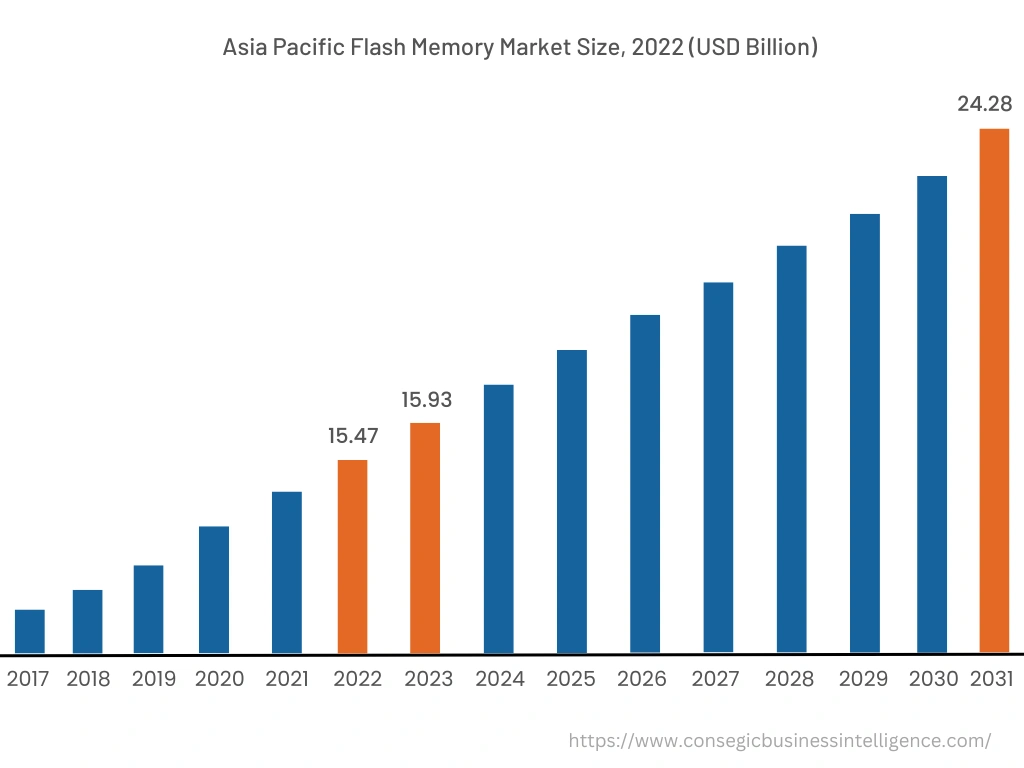
North America is estimated to reach over USD 36.17 Billion by 2031 from a value of USD 23.93 Billion in 2022 and is projected to grow by USD 24.56 Billion in 2023. The market growth for flash memory in the North American region is primarily driven by the deployment of the chip in enterprises, consumer electronics, medical, and other sectors. Moreover, rising development of enterprise data centers and increasing demand for high-capacity server and storage solutions in data centers are among the significant factors driving the market growth in the region.
For instance, in January 2023, ManageEngine, a division of Zoho Corporation, announced the launch of two new data centers in Montreal and Toronto cities in Canada, with the aim of offering Canadian customers the benefits of localized data centers with enhanced data security and functionality. The above factors are driving the integration of flash memory for application in data center servers, storage, and networks for storing large volumes of data and electronic information, in turn driving the market growth in North America. Furthermore, the increasing investments in consumer electronic devices and medical devices are projected to drive the market growth in North America during the forecast period.
Asia-Pacific is expected to grow with the highest CAGR growth of 5.4% and is estimated to reach over USD 24.28 Billion by 2031 from a value of USD 15.47 Billion in 2022 and is projected to grow by USD 15.93 Billion in 2023. In addition, in the region, the China accounted for the maximum revenue share of 31.6% in the same year. The growing pace of industrialization and development is creating lucrative growth aspects for the market in the region. Additionally, factors including the growth of various industries including consumer electronics, military & defense, and others are driving the market growth for flash memory in the Asia-Pacific region.
For instance, according to the India Brand Equity Foundation, the consumer electronics sector in India was valued at USD 9.84 billion in 2021, while it is estimated to grow at a significant rate to reach USD 21.18 billion by 2025. Flash memory is primarily used in the consumer electronics industry for storage and data transfer applications, particularly in smartphones, computers, digital cameras, television, wearable devices, and other related consumer devices. Therefore, the growing consumer electronics sector in the Asia-Pacific region is anticipated to drive the utilization of flash memory, thereby proliferating market growth in the region during the forecast period.
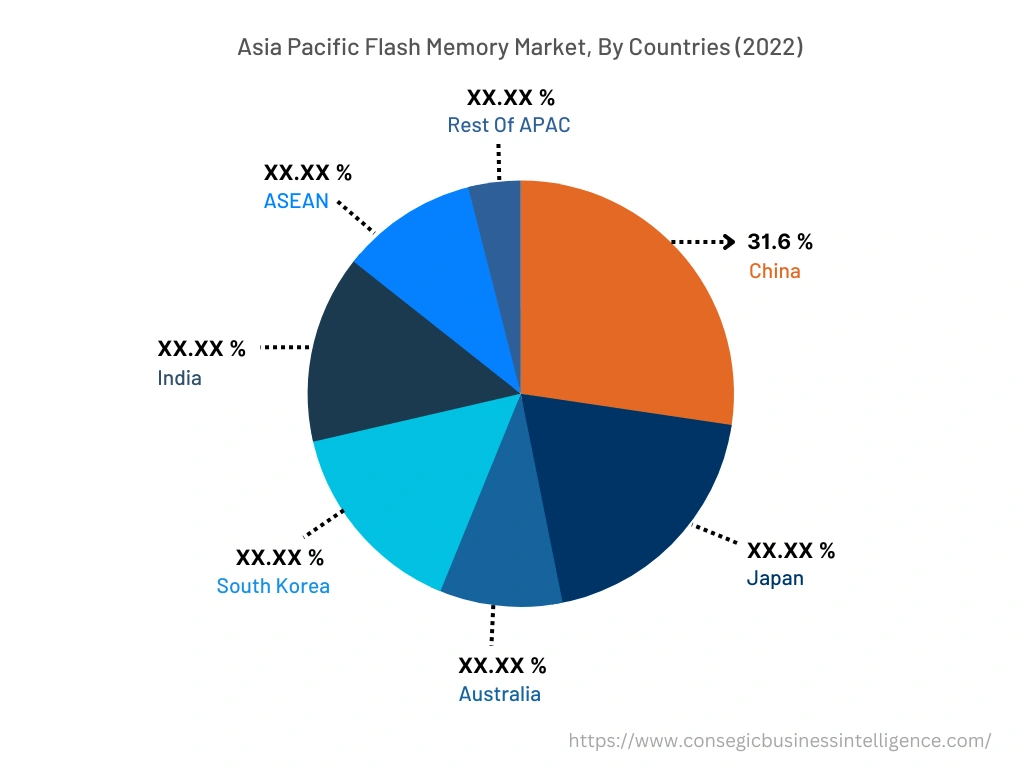
Top Key Players & Market Share Insights:
The flash memory market is highly competitive with major players providing flash memory to the national and international markets. Key players are adopting several strategies in research and development (R&D), product innovation, and end-user launches to hold a strong position in flash memory market. Key players in the flash memory market include-
- Samsung
- STMicroelectronics
- Microchip Technology Inc.
- KIOXIA Holdings Corporation
- Renesas Electronics Corporation
- Micron Technology Inc.
- Toshiba Corporation
- SK Hynix Inc.
- Intel Corporation
- Infineon Technologies AG
Recent Industry Developments :
- In September 2023, Kioxia Corporation introduced next generation e-mmc ver. 5.1-compliant embedded flash memory products flash memory products that are particularly designed for utilization in consumer applications.
Key Questions Answered in the Report
What is flash memory? +
Flash memory refers to an electronic non-volatile computer memory storage medium that can be electrically erased and reprogrammed.
What specific segmentation details are covered in the flash memory report, and how is the dominating segment impacting the market growth? +
For instance, by type segment has witnessed NAND flash memory as the dominating segment in the year 2022, owing to its increasing utilization in consumer electronics, medical devices, and other related applications.
What specific segmentation details are covered in the flash memory market report, and how is the fastest segment anticipated to impact the market growth? +
For instance, by end-user segment has witnessed enterprise as the fastest-growing segment during the forecast period due to rising adoption of flash memory in enterprise data centre servers, storage, and networking solutions among others.
Which region/country is anticipated to witness the highest CAGR during the forecast period, 2023-2031? +
Asia-Pacific is anticipated to register fastest CAGR growth during the forecast period due to rapid pace of industrialization and growth of multiple industries such as including consumer electronics, military & defence, and others.
